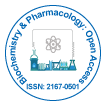
Biochemistry & Pharmacology: Open Access
Open Access
ISSN: 2167-0501

ISSN: 2167-0501
Short Communication - (2025)Volume 14, Issue 1
Nanocarrier-based drug delivery systems have emerged as transformative platforms in modern pharmaceutical sciences, offering highly targeted, efficient, and controlled therapeutic delivery. Over the past two decades, these nanoscale vehicles ranging from liposomes, dendrimers, polymeric nanoparticles, to micelles and solid lipid nanoparticles have reshaped the approach to treating diseases, especially those involving complex biochemical environments such as cancer, neurodegenerative disorders, and infectious diseases. The principle driving nanocarrier technology is the ability to exploit physicochemical and biochemical interactions at the nanoscale, facilitating improved bioavailability, reduced systemic toxicity, and enhanced therapeutic index of loaded drugs. These systems are engineered to carry drugs through physiological barriers while preserving the therapeutic agent's integrity and releasing it in a controlled manner at the intended site of action [1].
From a biochemical standpoint, the interaction of nanocarriers with biological systems is fundamental to their function. Upon systemic administration, nanocarriers encounter a complex milieu consisting of plasma proteins, immune cells, and enzymatic activity. One of the earliest events is the formation of a “protein corona” around the nanoparticle, which alters its surface properties and affects recognition by target tissues or immune clearance. To address this, surface modifications such as polyethylene glycol are employed to reduce opsonization and prolong circulation time. Additionally, targeting moieties like antibodies, peptides, or ligands are conjugated to the surface of nanocarriers to facilitate receptor-mediated endocytosis, ensuring selective uptake by diseased cells. This biochemical tuning not only enhances specificity but also reduces off-target effects, which is particularly critical in oncology where conventional chemotherapeutics often damage healthy tissues [2].
The internalization of nanocarriers into target cells is a process heavily influenced by cellular biochemistry, especially the mechanisms of endocytosis and intracellular trafficking. Once internalized, nanocarriers must escape endosomal entrapment to release their payload into the cytoplasm or transport it to organelles such as the nucleus or mitochondria, depending on the therapeutic goal. This step is often aided by pH-sensitive or enzyme-sensitive linkers, which respond to the biochemical cues within intracellular compartments. For instance, many tumor microenvironments present acidic conditions and elevated levels of glutathione or specific enzymes like matrix metalloproteinases, which can be exploited for stimuli-responsive drug release [3].
Liposomes are among the earliest and most widely studied nanocarriers. Composed of phospholipid bilayers that mimic biological membranes, liposomes can encapsulate both hydrophilic and hydrophobic drugs. Their biocompatibility and ability to be functionalized with targeting ligands make them ideal for a range of applications. Liposomal formulations such as Doxil (liposomal doxorubicin) have received FDA approval and demonstrated improved safety profiles in clinical settings. Another noteworthy class is dendrimers—branched, tree-like polymers with well-defined molecular architectures that enable multivalent interactions and high drug-loading capacities. These nanocarriers are particularly attractive for gene delivery and targeted therapies, where multiple functional groups can be attached for site-specific action [4].
Polymeric nanoparticles, often constructed from biocompatible and biodegradable materials such as PLGA (PolyLactic co-Glycolic Acid), offer controlled and sustained drug release. Their degradation kinetics can be tuned biochemically to match the pharmacokinetic profile desired. Micelles, formed by the self-assembly of amphiphilic molecules, are particularly useful for delivering hydrophobic drugs, often a challenge in traditional formulations. These micelles disassemble in response to environmental stimuli, making them efficient in delivering poorly soluble chemotherapeutic agents [5].
Another innovation in this domain includes Solid Lipid Nanoparticles (SLNs) and Nanostructured Lipid Carriers (NLCs), which offer advantages such as physical stability, protection of labile drugs, and scalability in manufacturing. These lipid-based carriers exhibit favorable interactions with cellular membranes, enhancing drug absorption and permeability [6]. In addition, exosome-mimicking nanocarriers are being studied for their endogenous-like properties that allow efficient intercellular communication and minimal immunogenicity, thus providing a promising route for RNA-based therapies [7].
Nanocarrier drug delivery systems also hold potential in bypassing biological barriers such as the Blood-Brain Barrier (BBB), a major obstacle in treating Central Nervous System (CNS) diseases [8]. By exploiting receptor-mediated transcytosis and nanoparticle surface functionalization with ligands such as transferrin or lactoferrin, therapeutic agents can be ferried across this barrier. Furthermore, research in stimuli-responsive or "smart" nanocarriers that respond to biochemical triggers—such as pH, temperature, redox gradients, or enzymes—continues to push the boundaries of targeted drug delivery [9].
Despite the promising outlook, there are challenges associated with the clinical translation of nanocarrier-based systems. Biochemical complexity of the human body often results in unpredictable pharmacokinetics and biodistribution. Additionally, long-term safety, immunogenicity, and large-scale reproducibility are areas of ongoing investigation. Regulatory pathways also remain complicated, partly due to the intricate design and multifunctional nature of these carriers. Therefore, interdisciplinary collaboration among biochemists, pharmacologists, materials scientists, and clinicians is crucial to streamline development and regulatory acceptance [10].
Citation: Aoyama H (2025). Nanocarrier-Based Drug Delivery Systems: A Biochemical Perspective. Biochem Pharmacol.14:381.
Received: 03-Feb-2025, Manuscript No. BCPC-25-37579 ; Editor assigned: 05-Feb-2025, Pre QC No. BCPC-25-37579 (PQ); Reviewed: 19-Feb-2025, QC No. BCPC-25-37579 ; Revised: 26-Feb-2025, Manuscript No. BCPC-25-37579 (R); Published: 04-Mar-2025 , DOI: 10.35248/2167-0501.25.14.381
Copyright: © 2025 Aoyama H. This is an open-access article distributed under the terms of the Creative Commons Attribution License, which permits unrestricted use, distribution, and reproduction in any medium, provided the original author and source are credited.